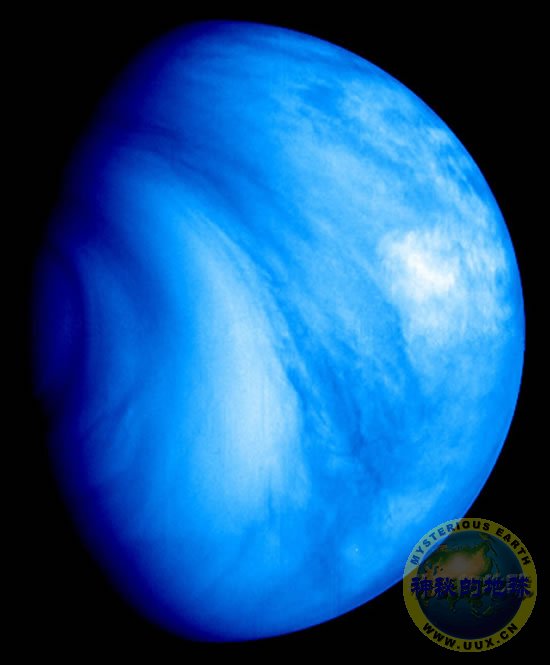Venus Craft Reveals Lightning, Supports Watery Past
The southern hemisphere of Venus shines like a bright blue marble in this infrared image from the Venus Express spacecraft.
The latest findings from the European mission support theories that the inhospitable planet once harbored oceans that boiled away due to rampant greenhouse warming.
Image courtesy ESA © 2007 MPS for VMC Team MPS/DLR-PF/IDA
James Owen
for National Geographic News
November 28, 2007
Despite its currently hellish environment, Venus started out much like our own planet and still shows some surprisingly Earthlike traits, scientists announced today.
The discoveries mark the first findings from Venus Express, a European Space Agency (ESA) craft launched in November 2005 to investigate our "sister" planet.
Observations from the first year of the mission suggest that Venus experiences lightning storms, hurricane-force atmospheric winds, and massive cloud vortexes over both its polar regions.
The mission also found evidence as to why Venus turned out more like Earth's "evil twin" despite being similar in size, mass, chemical makeup, and distance from the sun.
"Earth is a water planet, and Venus is its near-twin, so what happened to all the water" on Venus, asked team member David Grinspoon of the Denver Museum of Nature and Science in Colorado.
"Fortunately, we now have some clues."
Case of the Missing Water
Venus is the second planet from the sun and is only a few hundred miles smaller in diameter than the third planet, Earth.
But Venus's thick, rapidly spinning clouds create a scorching atmosphere with an average temperature of 864°F (462°C) and a surface pressure roughly 90 times that of Earth's.
Like present-day Earth, Venus could once have been covered in oceans, although the only water there now exists as vapor or as traces dissolved in vast clouds of sulfuric acid.
(Read "Early Venus Had Oceans, May Have Been Habitable" [October 11, 2007].)
Scientists suspect Venus's oceans may have "boiled off" due to a runaway greenhouse effect that saw carbon dioxide levels rise until the gas made up 96.5 percent of the planet's atmosphere.
The latest findings, reported in this week's issue of the journal Nature, support this theory.
An instrument on the ESA spacecraft known as a plasma analyzer showed that the main ions escaping Venus's atmosphere are oxygen, helium, and hydrogen.
Hydrogen and oxygen ions were shown to be escaping in the same proportions as they are found in water, H2O—providing a likely mechanism for how water has been leaving Venus.
"If you break up an H2O molecule, the hydrogen and oxygen escape at a proportional rate, so that seems to be where the water's going," Grinspoon said today at a press conference at ESA headquarters in Paris, France.
Further evidence for Venus's vanished water comes from high levels of atmospheric heavy hydrogen, or deuterium, the study team said.
"As hydrogen escapes, it leaves behind the heavier deuterium, so the amount of deuterium residue is an important clue to the amount of water that's been lost," Grinspoon said.
Estimates based on Venus's levels of deuterium suggest that the planet has lost anywhere from 13 feet (4 meters) of surface water up to "an Earth's ocean's worth," the scientist added.
Analysis of newly gathered data on the amounts of deuterium found at different levels of Venus's atmosphere should lead to much better estimates of exactly how much water has disappeared into space, Grinspoon said.
Lightning Strikes
The Venus Express team also found unexpected evidence for a warm layer of air 56 to 75 miles (90 to 120 kilometers) above the night side of the planet.
Previously the upper atmosphere of Venus's night side was thought to be so cold that it was named the cryosphere.
Violent winds were also detected in the planet's upper atmosphere. At 43 miles (70 kilometers) above Venus's surface, wind speeds reached 225 miles (360 kilometers) an hour.
In addition, the mission team found that Venus, like Earth, has huge areas of circulating air over both its polar regions.
But Venus's mass of swirling polar clouds forms a double vortex with temperatures much higher than the surrounding area. The warm air may be evidence of a planetary circulation system, with hot air flowing to the poles from equatorial regions.
The ESA spacecraft also provided the first solid evidence for lightning on Venus, according to the study team.
"It's quite possible there's as much lightning on Venus as on Earth," team member Grinspoon said.
This finding is highly surprising, according to planetary scientist Andrew Ingersoll with the California Institute of Technology in Pasadena, California.
"There shouldn't be any [lightning] on Venus, whose clouds are like [Earth's] smog clouds, which do not produce lightning," Ingersoll wrote in a commentary also appearing in Nature.
"Perhaps we have simply not thought of all the ways electricity can be generated in a planetary atmosphere," he added.
Venus Express mission scientist Fred Taylor from the University of Oxford, England, said that while Venus's climate is very different from Earth's, there are many common processes at work.
"On Venus, these have worked to virtually eliminate water from the planet while maintaining high levels of carbon dioxide, while Earth has retained much of its water and lost most of its atmospheric carbon dioxide," he said.
"In the light of the new data, it is possible to construct a scenario in which the climates on Venus and Earth were very similar when they started out, and then evolved to the state we see now, like twins separated at birth," Taylor said.
"Billions of years ago there is even the possibility that Venus would have been habitable."












